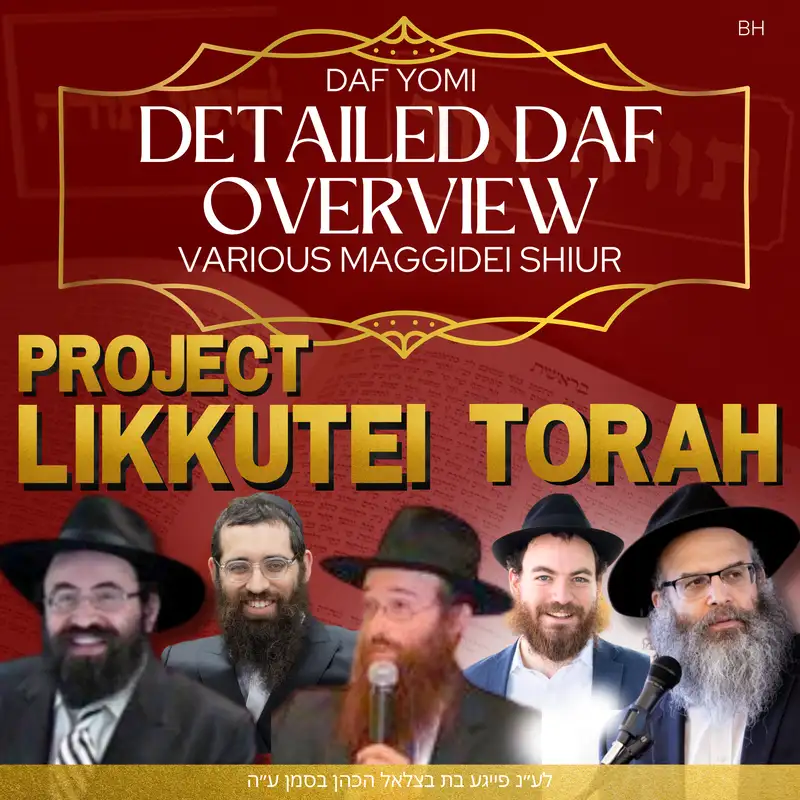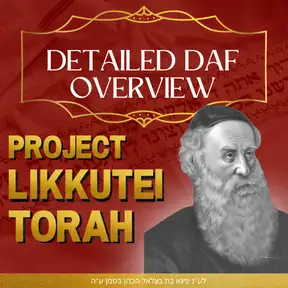
Torah Ohr Daf 56 - What can WE do that Avraham Avinu Couldn't? w/ Rabbi Dovid Leib Shmerling
Summary
“Vaeirah el Avrham…”: Shaddai= the contemplation which leads to spiritual emotions (the Avos). Although this level of Hashem was revealed to the Avos (and is an aspect of our current avodah), “ushmi Havayeh lo nodaati lahem”. The avos performed the Mitzvot with great emotion, and yet it is this emotion that allows them to remain, in some way, independent from Hashem (emotions can only be based on the aspects of Hashem that we can understand, which are the lower levels of Elokus). However, Moshe Rabbeinu embodied the quality of absolute bittul, which is why the Torah was given through him. Torah and Mitzvot come from the deepest levels of Elokus, which are beyond understanding and emotion and can only be expressed through bittul. They also draw the deepest level of bittul (Yachid, Anochi mi sh’Anochi) into our Neshamos and this world. This is what was unique about Moshe, and the meaning of “ushmi Havayeh…”. ConceptsThe difference between emotion and action in Avodas Hashem. Vayidaber ElokimSummary“Vayidaber Elokim el Moshe vayomer eilav Ani Havaya v’eirah el Avraham…”Q1: in what way does this answer Moshe’s questions of “lama haroisa laam hazeh”?Q2: why did BN”Y have to go into Galus Mitzrayim?Creation comes from a fusion of Shem Havayeh and Shem Elokim. We need to understand the nature of these two names.Elokim. Elokim is plural, and this name represents the way Hashem invests Himself in every particular facet of creation, both physical and spiritual (Malchus,“mah rabu”, “mah gadlu”.) This investment is what allows us to apprehend Hashem and His greatness (“emasai gadol k’shehu be’ir Elokeinu”) but is also only a miniscule aspect of Hashem that is negligible relative to Hashem Himself (“ki shemesh umagen”, ziv v’haraha).Havaya is the single, simple source of all of the multiplicity that flows from Shem Elokim. Elokim is also the source of one love and fear of Hashem, which initially comes from one’s contemplation on the way Hashem is present in every aspect of creation. However, the ultimate goal is to reach a higher love of Hashem which relates to the way Hashem is really beyond all of creation. This is given as gift from Hashem once one has completed the first type of love. However, even this higher level of love needs to go through a number of tzimtzumim until it can be given to a person. (yichud Havayeh v’Elokim al yidei shem Shadai). Thus, the Avos (and our emotions) only related to the way Havayeh is “filtered” through Elokim. But through Torah and Mitzvos, we reach the pure level of Havayeh. This ability was only reveled by Matan Torah (ushmi Havayeh). Every Gilui Elokus occurs in a way of Ratzu and Shuv (Mati v’Lo Mati), in which Elokus is not apparent in the world so that it can then be expressed in a new way. The intended level of Gilui effects a corresponding level of Galus. Thus, in order to receive the novel Gilui of Matan Torah, we had to go into Galus Mitzrayim. This also applies to our current Galus: its length and depth are commensurate with the length and depth of the Gilui of Moshiach. In Avodah, the idea of Havayah Elokim= Middos, Bchol Levavcha. The level of Havayeh L’Vado= Bchol Nafshecha, total Bittul. Concepts The meaning of Shem Havayeh and Shem ElokimGalus is commensurate with Geulah. Support the show- “Vaeirah el Avrham…”: Shaddai= the contemplation which leads to spiritual emotions (the Avos).
- Although this level of Hashem was revealed to the Avos (and is an aspect of our current avodah), “ushmi Havayeh lo nodaati lahem”. The avos performed the Mitzvot with great emotion, and yet it is this emotion that allows them to remain, in some way, independent from Hashem (emotions can only be based on the aspects of Hashem that we can understand, which are the lower levels of Elokus).
- However, Moshe Rabbeinu embodied the quality of absolute bittul, which is why the Torah was given through him. Torah and Mitzvot come from the deepest levels of Elokus, which are beyond understanding and emotion and can only be expressed through bittul. They also draw the deepest level of bittul (Yachid, Anochi mi sh’Anochi) into our Neshamos and this world. This is what was unique about Moshe, and the meaning of “ushmi Havayeh…”.
Concepts
- The difference between emotion and action in Avodas Hashem.
Vayidaber Elokim
Summary
- “Vayidaber Elokim el Moshe vayomer eilav Ani Havaya v’eirah el Avraham…”
Q1: in what way does this answer Moshe’s questions of “lama haroisa laam hazeh”?
Q2: why did BN”Y have to go into Galus Mitzrayim?
- Creation comes from a fusion of Shem Havayeh and Shem Elokim. We need to understand the nature of these two names.
- Elokim. Elokim is plural, and this name represents the way Hashem invests Himself in every particular facet of creation, both physical and spiritual (Malchus,“mah rabu”, “mah gadlu”.) This investment is what allows us to apprehend Hashem and His greatness (“emasai gadol k’shehu be’ir Elokeinu”) but is also only a miniscule aspect of Hashem that is negligible relative to Hashem Himself (“ki shemesh umagen”, ziv v’haraha).
- Havaya is the single, simple source of all of the multiplicity that flows from Shem Elokim.
- Elokim is also the source of one love and fear of Hashem, which initially comes from one’s contemplation on the way Hashem is present in every aspect of creation. However, the ultimate goal is to reach a higher love of Hashem which relates to the way Hashem is really beyond all of creation. This is given as gift from Hashem once one has completed the first type of love.
- However, even this higher level of love needs to go through a number of tzimtzumim until it can be given to a person. (yichud Havayeh v’Elokim al yidei shem Shadai). Thus, the Avos (and our emotions) only related to the way Havayeh is “filtered” through Elokim. But through Torah and Mitzvos, we reach the pure level of Havayeh. This ability was only reveled by Matan Torah (ushmi Havayeh).
- Every Gilui Elokus occurs in a way of Ratzu and Shuv (Mati v’Lo Mati), in which Elokus is not apparent in the world so that it can then be expressed in a new way. The intended level of Gilui effects a corresponding level of Galus. Thus, in order to receive the novel Gilui of Matan Torah, we had to go into Galus Mitzrayim. This also applies to our current Galus: its length and depth are commensurate with the length and depth of the Gilui of Moshiach.
- In Avodah, the idea of Havayah Elokim= Middos, Bchol Levavcha. The level of Havayeh L’Vado= Bchol Nafshecha, total Bittul.
Concepts
- The meaning of Shem Havayeh and Shem Elokim
- Galus is commensurate with Geulah.
